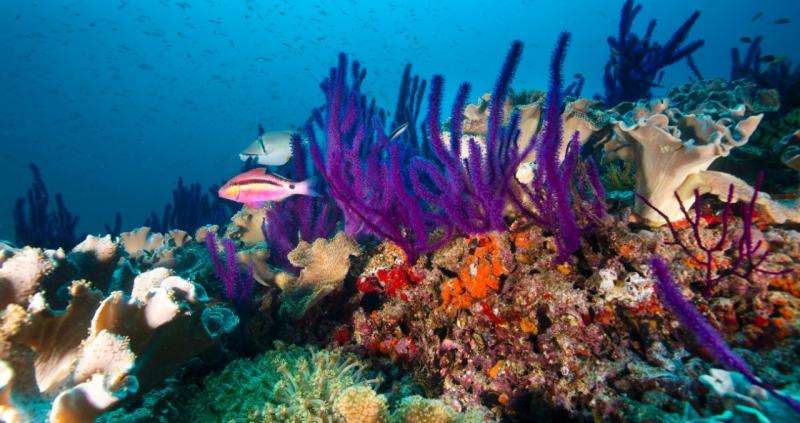Climate change lessons from Arabian Gulf coral reefs

Somewhere on Lake Erie, leaning over the rail of a research vessel in a November snowstorm and trying not to be sick, John Burt decided he'd rather work in warmer waters.
"I realized I had a real fondness for the tropics," the marine biologist recalls, laughing over the fateful experience from back when he was earning his master's degree in freshwater biology.
Now, as head of NYU Abu Dhabi's Marine Biology Lab, Burt conducts his research in some of the warmest waters on record—the Arabian Gulf, also known as the Persian Gulf. And, as the world contemplates rising sea temperatures caused by climate change, his work there has wide-ranging implications.
In June, a team led by Ed Smith, a research scientist in Burt's lab, published a study comparing the genetic structure of coral and their algae partners, or symbionts, in the Arabian Gulf and the neighboring Gulf of Oman. Their goal? To try to understand how coral in the Arabian Gulf have adapted to temperatures that can top 36 degrees Celsius (97 degrees Fahrenheit), about 5 degrees hotter than the average temperatures in the Gulf of Oman. The water off Miami Beach in August, for comparison, maxes out at 86 degrees Fahrenheit, according to the National Oceanic and Atmospheric Administration.
"The prospect of investigating the thermal tolerance of Gulf corals brought me to NYUAD," says Smith. "Undertaking research which could help further our understanding of how corals may respond to climate change is exciting, and this paper was an important step in our wider study into what makes these corals so special."
Coral reefs have been on the decline in recent years, in part because of "bleaching"—a breakdown in the relationship between coral and algae, which depend on each other for nutrients. According to Smith's study, bleaching has been documented with an increase in temperature of only 1 or 2 degrees Celsius.
But tropical waters are expected to warm by as much as 4 degrees Celsius by the end of this century.
The balance between coral and algae is "incredibly important," says Burt, an associate professor of biology who was one of the first faculty members to join NYU Abu Dhabi.
"Symbionts can survive on their own, but corals need that symbiont to survive," he says. "Corals get more than 90 percent of their energy from symbionts."
The consequences of coral loss are potentially devastating: Reefs are a significant source of fish for coastal communities and commercial fishing enterprises, supplying protein for up to a billion people, according to the Coral Reef Alliance.
The study, "Genetic structure of coral-Symbiodinium symbioses on the world's warmest reefs," which builds on earlier work by NYU postdoctoral researcher Emily Howells and others, shows that coral and algae in the Arabian Gulf and the Gulf of Oman are genetically distinct.
"What the results of these various studies tell us is that both the coral and their symbiotic algae have genetically adapted to extreme temperatures," Burt says. "If there was a means for this thermal tolerance to genetically spread to other regions, there is the possibility that corals there too could cope with future climate change."
But Burt is quick to dispel the notion that Arabian Gulf coral and algae are a miracle cure for rising sea temperatures elsewhere. Human-assisted migration of the coral and algea to other areas could introduce new diseases or parasites to a body of water, while natural dispersal might result in cross-breeding between so-called thermotolerant species and less tolerant species, negating the thermotolerant advantage. Instead, the hope is that coral in other seas will seek out thermotolerant algae the way coral in the Arabian Gulf have, thereby boosting their survival chances.
Burt calls the Arabian Gulf a "phenomenal natural laboratory" for research on coral hosts and algae symbionts, which has been a collaborative effort among scientists at NYU Abu Dhabi, the University of Southampton, the University of Oregon, and Zayed University in the United Arab Emirates (UAE). It also has been the base for Burt's research into how marine ecosystems respond to coastal infrastructure, including high-profile projects such as the Palm Jumeirah, a man-made island in the shape of a palm tree that is home to 4,000 luxury villas and apartments in the UAE.
"Humans aren't going to stop building cities along coastlines," he says. "So are there ways we can develop them in a more environmentally sustainable manner?"
Burt, who spent his childhood summers traveling the coastal Canadian waters near his family home in Nova Scotia, has worked in every country along the Arabian Gulf except Iran—"Once the embargo is lifted, I'm over there on the first flight," he says—and hosted workshops and conferences dedicated to enhancing conservation. So far, he says, efforts to responsibly care for the water have risen above politics in the region.
"Coral reefs, marine systems—they don't recognize borders," he says. "The Arabian Gulf is one shared body of water that needs to be managed cohesively by all states. It doesn't make any sense to limit collaboration when it comes to coastal management and science."
Provided by New York University




















